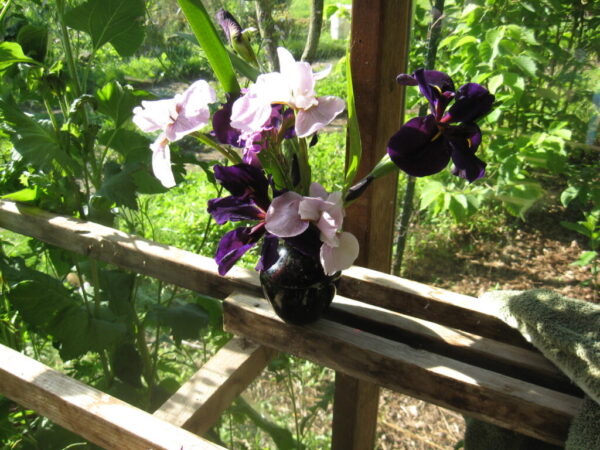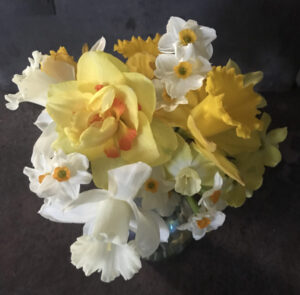- Like
- Digg
- Del
- Tumblr
- VKontakte
- Buffer
- Love This
- Odnoklassniki
- Meneame
- Blogger
- Amazon
- Yahoo Mail
- Gmail
- AOL
- Newsvine
- HackerNews
- Evernote
- MySpace
- Mail.ru
- Viadeo
- Line
- Comments
- Yummly
- SMS
- Viber
- Telegram
- Subscribe
- Skype
- Facebook Messenger
- Kakao
- LiveJournal
- Yammer
- Edgar
- Fintel
- Mix
- Instapaper
- Copy Link
A version of this column first ran in the Roane County (WV) Reporter and Times Record as part of a gardening series. Support local journalism! Subscribe to your local newspaper. This is one of a series of blogs for new gardeners. Start reading the whole series here: Part 1.

My whole purpose with this column has been to persuade you to grow some of your food, and assist you in doing so. Nonetheless, this week, just once, I’m going to step away from the garden and into…the flowerbed. There is a reason this column appears now: this is the time of year when I waste a lot of time leering at flower catalogs and considering what to order…because I can’t do much else in the garden and I’ve already made my decisions on the more prosaic vegetables.
I remember one column in which I pointed out the benefits of growing some flowering plants and herbs right in your garden: attracting pollinators and predator bugs, mainly. To some degree this is still true even if you have an ornamental garden separate from your vegetable garden and orchard, as long as it isn’t hundreds of feet away.
But your main reason for growing ornamentals, if you’re like me, is sheer disgusting self-indulgence; I love the eye candy of flowers, both in their beds in the spring breeze (and the summer fog and fall sun) and in their vases in my house. I often have four vases going at once, with different sizes and color schemes.
Sometimes I think color matters to me more than it does to normal people. I have no trouble understanding what Alice Walker meant by The Color Purple. For example, speaking of purple, last year some plants I had in the upper strip of my garden bloomed. They’d been given to me the previous year with the words, “I think it’s some kind of lily.” It didn’t look like a lily, and once it bloomed I knew I was right—it was some kind of iris. Specifically, I decided, a Louisiana iris. It was a deep, intense, velvety purple with small gold tabs. And I thought it would look nice with a Siberian iris I already had, called Pink Haze but actually lavender. I even had a purple vase to put the two in and boy, they did look smashing.
So, if you’re thinking of adding ornamentals to your planting this year, whether in among your vegetables or in their own space, here is some advice. First, your ground needs to be improved in much the same way a vegetable garden needs to be improved, but one difference is that you want full sun for nearly all vegetables. Some ornamentals want full sun but others prefer part shade, so a space with decent soil but a fair amount of shade could be a good place to put a flowerbed. I, unfortunately, do not have such a space now—I have a good shade bed right next to my house and I have put a couple of shrubs there, but the soil is abysmally bad, dense clay, so I have given up the idea of a shade bed. In one corner of this space, however, I keep my mushroom logs—the soil doesn’t matter for those.
Which flowers to grow? If you’re looking at a flower catalog, or looking online, it’s tempting to just order whatever thrills the cockles of your heart—and that should be the primary criterion! But there are others. No use ordering something that won’t survive in your garden. There are several potential issues here. First is climate. Your ornamentals come in several categories; annuals, perennials, vines, shrubs and bulbs. Vines and bulbs may also be either annuals—which means they’ll die at the end of one growing season—or perennials. Any perennial will die in a winter too cold for it, which is usually listed by climate zone. Ours is six. So if it says, “Hardiness zone 7 – 9” you’re fairly likely to lose it the first winter. Unless it’s a bulb, and you dig it up and hold it in dry dark conditions until spring and then replant it.
Another matter is soil condition. Plants that do well in the dry conditions out West often do poorly in the heat, humidity and wet winter conditions here. My flowerbed started as heavy clay, almost as bad as the shade bed. I amended the soil a lot but it tends to revert to clay—so it’s not surprising that plants listed as tolerating clay do especially well for me. One difference between ornamental and vegetable gardening is that there are very few perennial vegetables. This means you have the opportunity to amend and work your soil every year. You don’t want to disturb perennial plants, at least not often, so it isn’t so easy to keep their ground from reverting to its original condition.
So you want to choose plants that have a good chance of thriving in your conditions; plants that are pretty, in your eyes; and plants you can afford. Of course, if you can start something from seed it will be much cheaper, but be warned, some outfits sell seeds that can only be started by experts. Lastly, you want plants that go well together. You may have a color scheme for your whole garden, or parts of it. Often, different shades of the same hue are striking together—or the same shade in different shapes (like, tall blue spikes coming up between flat blue disks).
I am going to conclude with some suggestions. Daylilies are easy and reliable, and come in a wide selection of colors. Some are fragrant or rebloom. You can get them pretty cheaply. For bulbs, daffodils, or narcissi, are a good bet because they’re poisonous—nothing bothers them. They will persist, and probably multiply—I once found a clump near a homestead that had been abandoned for at least 50 years. Darwin Hybrid tulips may persist for years—but I lost mine last winter along with nearly all my lilies. Mice or chipmunks eat the bulbs in winter. I am planning to construct a wire cage because I can’t live without lilies. If you don’t have a fence around your flowerbed, you may need to choose items listed as resistant to deer, rabbits or mice.
I don’t plan to devote more columns to this subject but will be happy to give advice to anyone who asks a question below in the comments section…I have been indulging this vice for decades, along with the virtuous growing of vegetables and fruit.
Read the rest: Part 1. Part 2. Part 3. Part 4. Part 5. Part 6. Part 7. Part 8. Part 9. Part 10. Part 11. Part 12. Part 13. Part 14. Part 15. Part 16. Part 17. Part 18. Part 19. Part 20. Part 21. Part 22. Part 23. Part 24. Part 25. Part 26. Part 27. Part 28. Part 29. Part 30. Part 31. Part 32. Part 33. Part 34. Part 35. Part 36. Part 37. Part 38. Part 39. Part 40.













